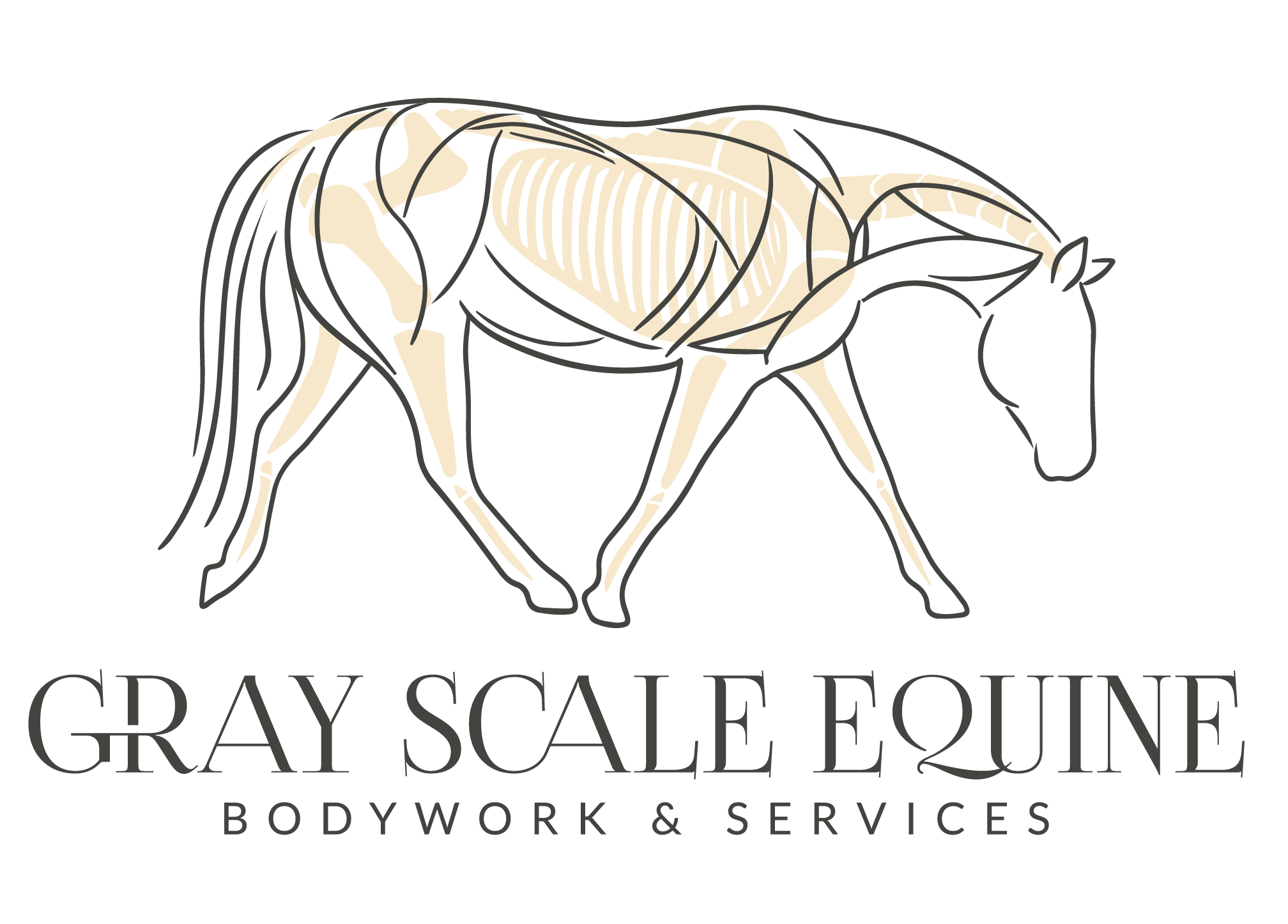
FAQs
Frequently Asked Questions
Get Answers and
Learn More About Equine Bodywork
There’s so much to know about equine bodywork, which is one of the many reasons I’ve created this FAQ page. Get answers to popular questions and get tips for your upcoming bodywork session.
Wondering how you know if your horse could benefit from bodywork? Here are some telltale signs that a horse needs bodywork done:
- Your horse is sore
- Your horse’s muscles are tight
- Your horse is struggling with lead changes or staying on the correct lead
- Your horse is having trouble jumping
- Your horse feels stiff or restricted
- Your horse won’t accept contact or resists collection
- Your horse’s posture is abnormal or they change their normal stance at rest
- Your horse has behavioral issues
- Your horse is girthy and/or sour when saddling
- Your horse is resistant to bend
- Your horse struggles with maintaining muscle tone and coat quality
- Your horse has an injury and the vet has cleared bodywork
- Your horse is compensation for an injury or poor conformation
- Your horse is an athlete and has a heavier work load
- Your horse expresses signs of irritation (pinned ears, tail swishing, stomping, head tossing, nipping, moving away from pressure, twitching, and pawing) while grooming, placing a saddle, touching parts of their body, etc.
- They aren’t coming under themselves and using themselves correctly
- Their stride is short/choppy/inconsistent
- They seem lazy/unwilling to go forward
- Your horse is tripping
- Your horse has been hollowing out their back
- Your horse has been tossing their head
- Your horse has been rearing and/or bucking
- Your horse has abnormal asymmetric muscle development
- Your horse has been breaking at gaits
- Your horse struggles with tight turns/circles
- Your horse drags their feet
- and so much more!
That being said, it is always a good idea to contact your vet first to rule out any other medical concerns that equine bodywork can’t fix. Equine bodywork is not veterinary medicine and we can’t diagnose, treat, or prescribe. Please refer to your vet for such things.
Unfortunately there is no one clear answer to this question. Each horse has their own customized maintenance plan due to every horse having different problems, lifestyles, work loads, disciplines, sensitivity, age, etc. These are some of the factors I take into consideration when I come up with a maintenance plan for your horse. Some horses may benefit from weekly bodywork sessions, while others can get away with monthly session or even bi-monthly sessions. This will be determined after my initial session. We can then get a read on your horse’s baseline and how long the results last for your specific horse and go from there. This is why client feedback/communication is so important. You know your horse better than anyone as you are the one working with and/or riding them everyday.
Decided to take the next steps and book your session? Here’s how to prepare for your horse’s upcoming session:
- If you haven’t already scheduled your appointment, please try your best to schedule for a day/time that does not interfere with any other procedures, feeding/turnout time, riding time, or too close to a horse show.
- Brittany will send you initial intake forms to get a detailed history on your horse. Please complete and submit this to Brittany prior to your appointment. Brittany will review this in preparation for your session.
- If this is your first session, please plan to have someone present who knows this horse well and can provide information to Brittany.
- Please plan to have someone present to hold your horse if necessary.
- Please plan to have someone available to jog your horse for Brittany at the beginning of the session and to hand walk your horse after the session.
- Please ensure there are no contraindications on the day of the session. If you have questions, please contact Brittany.
- If you plan to ride your horse the day of the session, please get them worked prior to your session.
- Please make sure that your horse is clean and dry for their session.
- Please do not feed treats or distract your horse during the session as they get the most out of it when they are focused on Brittany.
A GSE Equine Bodywork Session will include but is not limited to the following:
- An in-depth review of your horse’s history, concerns, and goals.
- Both a static and dynamic observation of your horse to start the session in order to identify areas of concern/tension to focus on during the session.
- 60-90 minutes of working on your horse with the following modalities:
- Sports Massage
- Myofascial Release
- Soft Tissue Mobilization
- Focal Point Work (Stress & Trigger Points)
- Stretching
- Range of Motion & Positioning Exercises
- Instruction on how to utilize certain techniques, stretches, and exercises to maintain your horse between sessions
- A detailed session report that goes over:
- What I observed during the initial observations and the session itself
- Areas of tension, concern, and asymmetries
- Level of sensitivity
- How your horse reacted
- A plan moving forward
- And finally, complete access to Brittany for all of your questions, concerns, and thoughts.
Believe it or not there are circumstances when your horse should NOT get bodywork done. We call these reasons contraindications. Here’s a few examples:
- Abnormal vitals (Temperature, Respiration Rate, Pulse, Mucas Membranes)
- Any signs of illness
- Heat/Swelling
- Hives
- Lameness
- Certain Stages of Pregnancy
- Other Procedures Being Done (Chiropractic, Dentals, Injections, Vaccines, etc.)
- Tying Up
- Neurologic
- Excessive Loose Stool
- Extreme Behavior Changes
- Skin Conditions
- Cancer
These contraindications need to be cleared by a veterinarian or resolve before I am able to work on your horse. Each scenario is different so please reach out to Brittany or your veterinarian if you have any questions or concerns!
Disclosure: Brittany is not a veterinarian and is unable to diagnose, treat, or give medical advice. Please refer to your veterinarian for such things.
Unsure about equine bodywork? Don’t want to waste your money?
I don’t want you to waste your money either! Equine Bodywork can honestly do so much for you and your horse! Take a look at a few of the benefits:
- Aids in injury prevention
- Enhances performance
- Increases range of motion & flexibility
- Improves coat quality & muscle tone
- Increases circulation
- Decreases pain & inflammation
- Promotes healing & recovery
- Loosens scar tissue
- Improves posture/asymmetries
- Decreases stress & tension
- Supports the immune system
- Releases endorphins
- And so much more
Equine bodywork can help with things like body soreness, asymmetries, stride length, lead changes, jumping, lateral work, overall performance, attitude/behavior, vices, injuries, recovery, building muscle, etc.
The list goes on!
You should always be mindful of who you hire to work on your horse. Unfortunately there are some programs out there that do not provide the best training in this field. That being said, Brittany is extremely qualified:
- B.S. in Equine Studies from Centenary University
- Equine Bodyworker Certification from Equinology
- Apprenticing under Freely Forward Bodywork, an equine myofascial release specialist.
- Years of extensive working experience in the industry. Grooming & managing up to the FEI level nationally and internationally, and experience as an equine veterinary technician.
- Education Topics:
- Equine Health & Management
- Saddle Fitting
- Equine MusculoskeletalSystem
- Biomechanics
- Riding & Training Exercises
- Course design
- Equine Nutrition
- Equine Gait Analysis
- Equine Facility Management
- Equine Business Management
- Conformation
- Equine Breeding Management
- Management of Equestrian Activities
- General Equine Science
- Bodywork Modalities: Sports Massage, Myofascial Release, Soft Tissue Mobilization, Focal Point Work (Stress & Trigger Points), Stretching, and Range of Motion & Positioning Exercises
GSE’s Post-Session Protocol will be included in your horse’s personal session report but these are the basics:
- For best results, hand walk your horse for a minimum of 10 minutes within 2 hours after your session.
- Plan to give your horse the rest of the day off from ridden work and plan to have a lighter ride the following day.
- Ensure that your horse has plenty of water available to them to rehydrate. Bodywork can be an intense experience and they may be more thirsty than normal after a session.
- Turnout is encouraged after a bodywork session.
- Be mindful that your horse may need some time to adjust to their new way of moving after a deeper session.
- Review your session report and follow the recommended stretches/exercises to maintain your horse between sessions.
- Don’t forget to update Brittany on how your horse is feeling following a session and feel free to leave a review!
While one bodywork session may improve your horse’s comfort and/or performance, it is unlikely that one session will ever fix a horse permanently no matter who the bodyworker is. Something caused your horse’s muscles to get sore/tight (for example: conformation, rider error, compensation, old age, work load, injury, etc.), their muscles will unfortunately go back to their previous condition if the root cause is not fixed. If the root cause is still present, your horse may need to be on a regular maintenance plan to keep them feeling their best. This looks different for each horse as each horse has different areas of concerns, lifestyles, reactions to bodywork, etc. Bodywork is typically utilized as a portion of your horse’s regular maintenance plan to keep these concerns at bay.
Ready to book a session but you’re unsure when to schedule for? Here are some things to consider:
- If your horse has contraindications, please get bodywork cleared by the vet prior to scheduling a session.
- Please refrain from scheduling a session during feeding, turnout, and riding time.
- If you plan to ride your horse the day of the session, please plan to ride prior to the session.
- Please do not schedule a session on the same day as other procedures or too close to other procedures getting done depending on what they are.
- Please schedule your session for a time that someone will be available to jog your horse, hold your horse if necessary, and hand walk your horse after the session.
- If you ever have any questions or concerns, please feel free to reach out to Brittany at any time.
“MagnaWave offers the latest in wellness technology through Pulsed Electromagnetic Fields. PEMF is used to cover low energy cells in raw, pure energy. Each cell in an animal’s body is actually just like a battery that holds a charge. Their body is electrical and the cells each need a measurable electrical charge to function optimally. In order to maintain good wellness, cells must be doing their jobs. MagnaWave uses PEMF to help support the animal’s overall wellness to optimize balanced functions.” – MagnaWave
PEMF (Pulsed ElectroMagnetic Fields) makes the cell membrane more permeable. It pushes oxygen in and pushes toxins out. This allows the body to function to it’s full potential in a natural and noninvasive way.
Yes, they are more than welcome to eat during their PEMF session.
Your horse should not receive a PEMF session if:
- They are pregnant
- They are actively bleeding
- They recently got joint injections
- They were recently vaccinated
- They are currently taking EPM medications
- They have a battery operated implanted device
- Their vitals are abnormal
- They are Ill
- They’ve had a recent organ transplant (more so directed towards humans)
Take the Next Steps
Get in Touch
Are you ready to take the next steps in helping your horse reach their full potential? Use the contact form below to tell me more.

